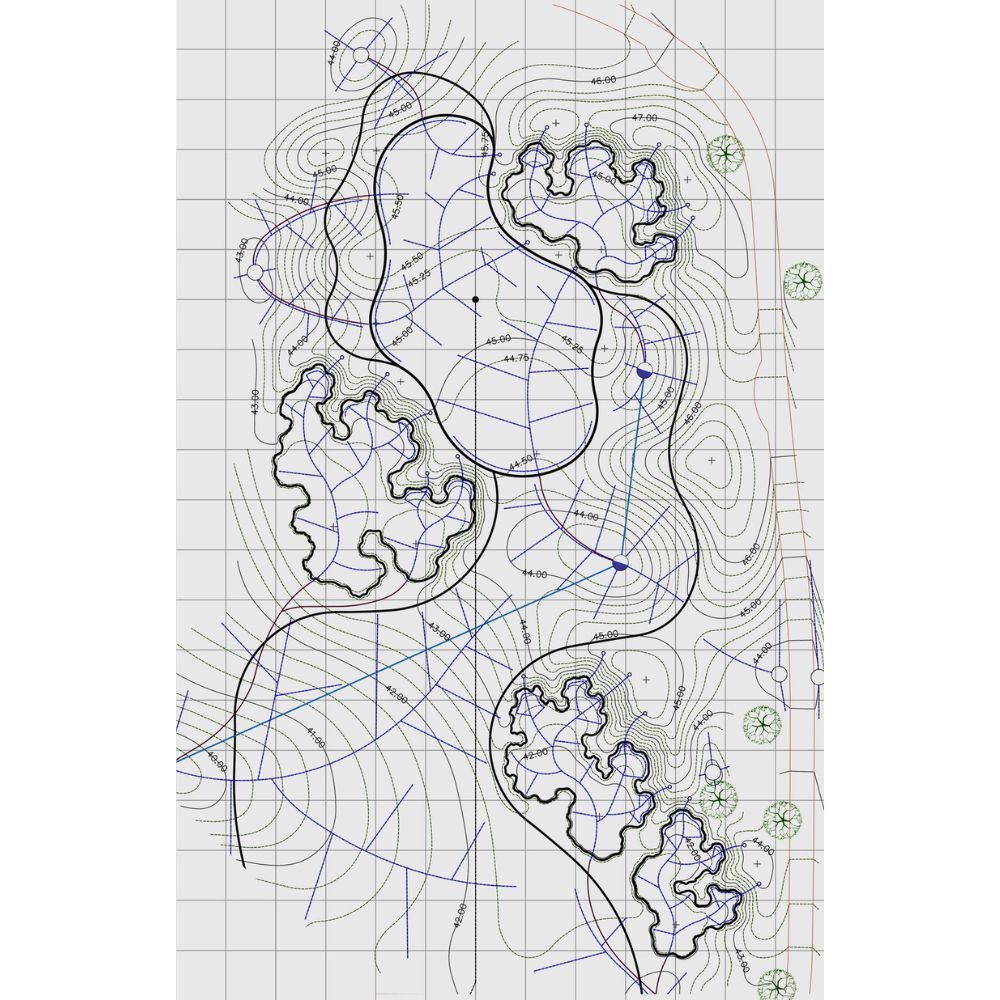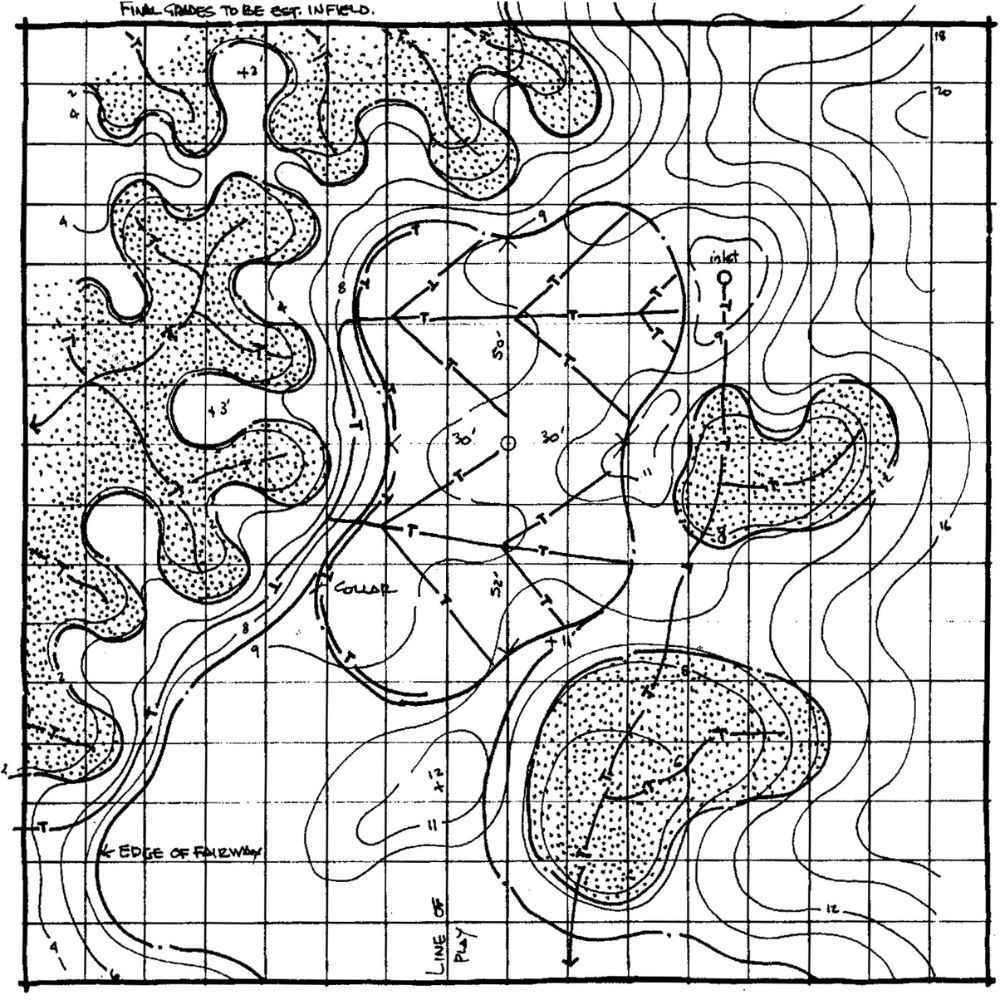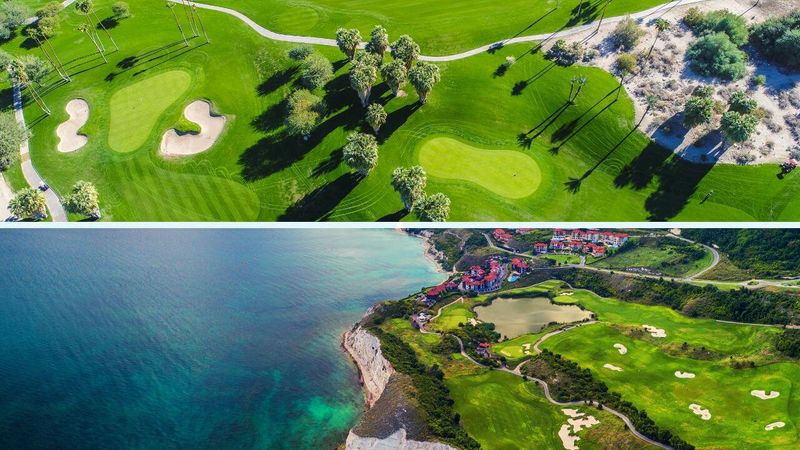Content Summary
Golf courses are an iconic part of the game we all know and love. But have you ever wondered what it would take to own one or what it takes to build one.
One of the first questions that came to my mind was, "how many acres is an average golf course?". Well, come to find out, the size of a golf course is determined by its design, the type of greens used, and many other factors.
How Many Acres Does It Take to Build a Golf Course?
The acreage of an 18-hole golf course can vary widely depending on factors such as the layout of the course, the size of each hole, and the surrounding terrain. However, a typical 18-hole golf course usually covers an area of 100-200+ acres.
There are some exceptions like the Pebble Beach Golf Links, located in Pebble Beach, California, which covers an area of approximately 375 acres. This includes the 18-hole golf course itself, as well as other areas such as the practice facilities, maintenance facilities, and clubhouse.
According to the United States Golf Association (USGA), the minimum size for an 18-hole course is 55 acres, but most courses range from 100 to 200 acres.
This includes the fairways, greens, tees, rough, and other areas such as water hazards, sand traps, and out-of-bounds areas. Some courses may also include additional features such as driving ranges, practice greens, and clubhouse facilities, which can add to the overall acreage.
The size of a golf course used for tournament play can vary depending on the specific event and the level of competition. Generally, championship golf courses used for professional tournaments will have larger acreage than regular golf courses.
For example, the United States Golf Association (USGA) recommends a minimum yardage of 7,000 yards for a course hosting a US Open Championship, which typically translates to around 150-200 acres of land. The PGA Tour also has minimum requirements for courses hosting their events, including a length of at least 7,200 yards for championship-level events.
However, the acreage of a golf course used for tournament play is not solely determined by its length. Factors such as the layout of the course, the number and size of hazards, the placement of bunkers and other obstacles, and the condition of the greens and fairways can all impact the overall acreage of the course.
In summary, golf courses used for tournament play are typically larger and more challenging than regular golf courses, but the exact size can vary depending on the event and the specific requirements of the governing organization.
Regardless of how much land is required for a golf course, the design of the course should be carefully planned and executed to ensure a quality playing experience for golfers.
No matter how big or small the acreage is, a golf course should be designed in a way that allows players to enjoy their time on the course while also providing challenging obstacles that will help improve their skills and game. By ensuring an enjoyable yet difficult layout, golf courses of all sizes can provide a rewarding experience for players.

18-Hole Golf Course Length
A typical 18-hole golf course usually measures between 6,000 and 7,000 yards in total length. The United States Golf Association (USGA) recommends a maximum length of 7,000 yards for an 18-hole course, although some courses may exceed this length.
Other factors such as the slope and rating of the course can also impact the difficulty level of the course, and some 18-hole courses may be more challenging than others despite having similar lengths.
This range is based on a par 72-course with four sets of tees for each hole (back, middle, forward and ladies). The distance between holes can also add to overall length because some courses will have long distances between certain holes while other courses may feature more compact fairways that are closer together.
On top of the physical acreage and yardage lengths, there are various obstacles such as water hazards and bunkers which also affect how long a golf course might play.
9-Hole Golf Course Length
The length of a 9-hole golf course can vary widely depending on factors such as the layout of the course, the size and shape of each hole, and the overall acreage of the course. However, a typical 9-hole golf course usually measures between 2,500 and 3,500 yards in total length.
The United States Golf Association (USGA) recommends a maximum length of 3,000 yards for a 9-hole course, although some courses may exceed this length. Other factors such as the slope and rating of the course can also impact the difficulty level of the course, and some 9-hole courses may be more challenging than others despite having similar lengths.
Physical acreage and yardage lengths can affect how long a golf course might play because of various obstacles such as water hazards and bunkers.
The Standard Golf Course Layout
The size of a golf course varies from as small as 60 acres to over 200 acres. The average golf course is around 150-175 acres. A standard golf course layout typically consists of seven parts: teeing ground, fairway, putting greens, rough, hazards, out of bounds and practice range.
Teeing ground is the starting point for each hole and is an area of closely mowed grass where the golfer takes their stance to hit the ball. Fairways are areas kept in a trimmed state leading up to the putting green with a few strategically placed bunkers or hazards along the way.
Roughs are longer grass areas which add challenge and difficulty by forcing players to aim more accurately off their shots while providing extra protection against errant balls being driven too far off line.
Hazards come in many forms such as sand traps or water hazards that require players to strategize how they will make it through them while keeping score in mind. Putting greens are specially designed surfaces which enable players to roll their ball closer towards the hole without having any major bumps or slopes that could affect its motion when hit with a putter club.
Out of bounds points on a golf course mark where balls must not be played from due to safety reasons or that may interfere with play on other holes nearby.

There are seven main parts to any golf course that should be given consideration when planning a golf course:
1. Teeing Ground
The teeing ground, or tee box, is the starting point of each hole on a golf course and occupies an area of approximately one acre. The teeing area was not previously given much consideration by golf course architects, but now they make sure that tees are attractively created.
The exact size can vary depending on the type of course and its design. But a general rule of thumb is that it is a 20-foot wide strip, beginning at the back edge of the tee box and extending to just before where the fairway begins. The tee box also includes two markers which indicate where players should stand in order to take their respective shots. These markers are typically referred to as "tee markers" or "tees".
Tee markers are used to indicate the placement of a golfer’s tee shot, and come in three different sets. The men's set is typically the furthest from the hole, followed by the women's set which is closer, and lastly a forward or junior set which is closest to the hole. The size of a golf course depends on how much acreage it occupies.
On average, an 18-hole regulation golf course requires approximately 150-200 acres for proper playability. In addition to that space, extra acreage may be needed for parking lots and other amenities such as driving ranges and clubhouses. Therefore, larger courses can require up to 300 acres or more depending on their design features and layout. Thus, for most courses with 18 holes, the total amount of land dedicated to tee boxes will be around 18 acres.
2. Fairways
The average golf course spans between 100-200 acres of land, with the exact acreage depending on the size and layout of the course. Most courses are designed with 18 holes spread throughout these acres, typically ranging from 5,000-7,000 yards in total length.
Fairways make up a large portion of this acreage and typically measure anywhere from 30-60 yards wide. Depending on the difficulty level and design of each hole, some fairways may be much narrower or wider than others. Fairways are typically made of grass that is cut to a particular height for optimal performance.
3. Putting Greens
Golf courses usually require a large amount of land; most are around 80 to 100 acres. However, the size can vary greatly depending on the type of course. Links courses, for example, tend to be much larger than inland courses due to the terrain characteristics that define links golf.
Furthermore, modern championship golf courses have seen a steady increase in size over the years due to increased demand for more challenging designs and longer distances. The USGA (United States Golf Association) recommends that an 18-hole championship golf course should occupy no less than 250 acres of land.
The greens on a golf course are particularly important as they provide the golfer with their first impression and initial challenge when playing each hole. On average, most golf greens measure between 4500-6000 square feet (roughly 0.1 acre).
They are typically made up of bentgrass or other fine grasses which require frequent care and maintenance in order to keep them looking pristine all year round. In addition, many golf courses also incorporate bunkers or sand traps into their green complexes in order to add further difficulty for players approaching these areas from different angles off the tee or fairway shot.
4. Rough Area
The size of the rough area also needs to be taken into consideration; this is an area of thicker grass situated around the fairway and greens which helps to define the hole boundaries and serves to challenge players during their rounds. A bigger rough will require more acreage, so courses with larger roughs tend to span a greater number of acres than those with smaller ones.
5. Hazards
Hazards are an integral part of any golf course. They can be bodies of water, vegetation and sand bunkers and are designed to add difficulty and challenge to the game, while also providing a unique aesthetic to the player’s experience.
The size and number of hazards will depend on the size of the golf course, with larger courses generally featuring more hazards than smaller ones. An 18 hole golf course may allocate between 15 and 30 acres to hazards However, this can vary depending on how many bunkers or water features have been included in the design.
6. Out of Bounds
Out of bounds on a golf course generally refers to any area that is off-limits to the players. This can include areas outside the boundaries of the golf course, such as residential streets, public roads, and other nearby land parcels. Out of bounds also includes areas within the golf course itself which are not part of the playing area.
These could include water features such as ponds and lakes, internal cart paths, maintenance buildings and equipment storage areas, or even hazards like bunkers or sand traps that have been designated as out of play. Knowing where these out-of-bounds areas are located is an important part of understanding how many acres are in a golf course since it will impact the size calculation for both tee boxes and fairways.
7. Driving Range Or Practice Range Area
Driving ranges are large areas of land and usually average around 10 acres that golfers can use to practice their swing and shot-making skills. They typically include several different teeing areas from which a golfer can hit shots into a designated area on the range where targets may be set up for practice.
These targets are often marked with flags or other markers so the golfer can focus on hitting the ball towards them. Many driving ranges also provide clubs and balls for rent, making them an ideal place to practice without having to bring your own equipment.
Additionally, they offer private lessons or group instruction from qualified instructors who can help players improve their game. Finally, most driving ranges have snack bars and pro shops located nearby in case players need any additional items while they're practicing.
Other Factors To Consider To Build A Golf Course
Factors such as terrain, trees and water hazards should also be taken into consideration when determining the total acreage needed for a golf course. Depending on the region’s climate, courses may require additional land for winter maintenance, irrigation and drainage systems. Finally, ancillary facilities such as parking lots, club houses, driving ranges and pro shop should not be overlooked when planning out a golf course project.
Environmental Factors
The size of a golf course is highly dependent on environmental factors. For example, the topography and soil type of the land can affect how large a course needs to be in order to provide an enjoyable experience for players.
Hills, valleys, and other geographical features can limit the available space for tee boxes, fairways, and greens. Similarly, soil types such as clay or sand can influence turf maintenance needs and ultimately the amount of acreage required for a playable 18-hole course.
Additionally, local weather conditions must be taken into account when planning a golf course; extreme temperatures or rainfall could limit the overall length of each hole while also greatly increasing maintenance costs due to increased wear and tear on turf areas from inclement weather.
Difficulty Level
The difficulty level of a golf course depends on the size and complexity of the layout, which varies greatly by location. Courses located in mountainous areas tend to be more difficult due to the natural features such as elevation changes, water hazards, and strategically placed bunkers that can affect the way shots must be played.
Similarly, courses with smaller acreage are likely to feature tighter fairways and greens that require more precision when hitting shots. Professional-level courses also incorporate additional challenges such as longer carries off the tee and more demanding pin placements to test players' skills.
Size Of The Clubhouse
The size of a golf course clubhouse can vary greatly depending on the size of the golf course. The size of the golf club often consists of several parts that make up its overall footprint. This includes a main building, pro shop, cart storage area, and other amenities such as restaurant or bar areas.
The main building typically contains offices for staff members and locker rooms for players. Pro shops are usually well stocked with clothing, equipment and accessories to suit all levels of golfer. Cart storage spaces provide places to store carts while they're not in use during rounds of golf. A bar or restaurant area may offer food or drinks after a round has been completed or even before it begins!
Golf Course Architecture
Golf course architecture is a specialized field that involves the design and construction of golf courses. A golf course architect is responsible for designing a course that is both challenging and enjoyable for golfers of all skill levels.
Most golf courses are designed by professional golf course architects, who take into account factors such as the terrain, water resources, soil quality, and environmental considerations. The Golf Course Superintendent Association provides guidance on the best practices for maintaining high-quality golf course turf.
How Much Does It Cost To Build A Golf Course?
Besides the land costs, other expenses associated with building a golf course include designing and engineering plans for the property; obtaining permits; purchasing materials such as grass seed, soil amendments and golf course turf/sod; grading roads and drainage systems; constructing buildings such as clubhouses or cart barns; installing irrigation systems; creating water hazards or bunkers; adding landscaping features like trees or shrubs; and ongoing maintenance costs once it's open.
The overall cost can range anywhere from hundreds of thousands to millions of dollars depending on the type and size of the project.
Where Is The Best Place To Build A Golf Course?
The terrain must be suitable for play, offering a combination of flat and hilly areas that will challenge even experienced players. Building a golf course also involves factors such as water drainage, soil conditions, and existing vegetation.
The best place to build a golf course is in an area with plenty of open space that is relatively undeveloped. This will provide ample room for the full 18-hole course design and other features like driving ranges or practice greens and if a residential golf community is in the plans.
It should also have good soil quality to ensure it drains well after rainstorms or irrigation cycles. Areas with existing trees or other vegetation can be utilized in the design process to create natural hazards that will add interest and challenge for players. Finally, access to amenities like lodging options and restaurants can help attract more people to visit the course when it opens.
How Long Does It Take To Build A Golf Course?
When it comes to building a golf course, the amount of time needed depends on the complexity and scope of the project. This includes things such as soil condition, terrain features, vegetation removal, drainage plans, irrigation systems and more.
For most golf courses it can take anywhere from 12 months to three years to build before it is ready for play. Factors that contribute to this timeline include weather conditions, job site access restrictions and local permits required for each construction phase.
Do You Need Permission To Build A Golf Course?
Building a golf course requires careful planning and approval from local authorities, specifically the Planning Commission. Depending on how large the course will be, it may require multiple permits.
A typical golf course can range between 100-200 acres. The amount of acreage needed will depend on the type of golf course being designed as well as local zoning regulations and other factors such as terrain, access to water sources and existing infrastructure in the area. In addition to the space required for construction, an additional buffer zone is often necessary for wildlife habitats or conservation areas that surround many courses.
Planning Commission
The Planning Commission must review each individual project in order to ensure that all requirements are met before granting permission for construction of a new golf course. This includes determining if there are any environmental or safety concerns that need to be addressed prior to beginning construction or if any special considerations need to be taken into account during development.
Additionally, due to potential disruption of surrounding ecosystems and aesthetics of an area, aesthetic considerations must also be taken into account when constructing a new golf course.
Conclusion
How many acres is required for an average course length can vary greatly depending on how the course is designed and how challenging it is intended to be. On average, a standard 18-hole golf course will occupy between 150 and 225 acres of land with some courses requiring up to 500 acres or more.
Ultimately, how much land is required depends on how the design of the course is planned and how it will play out for golfers. With the right amount of acreage and a well-planned course design, any golf course can provide an enjoyable experience for players.
Thank you for visiting, and we hope to see you back soon!








